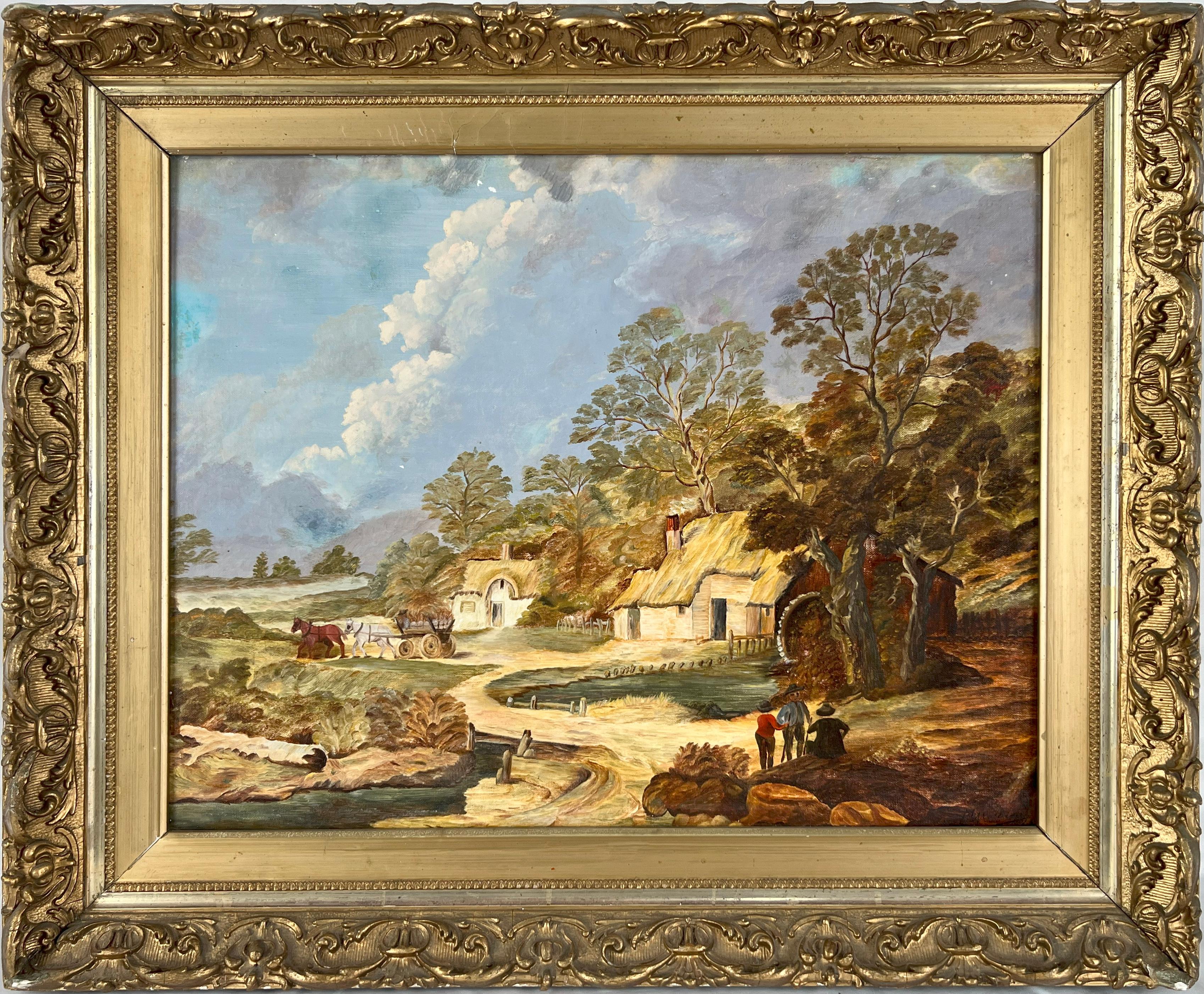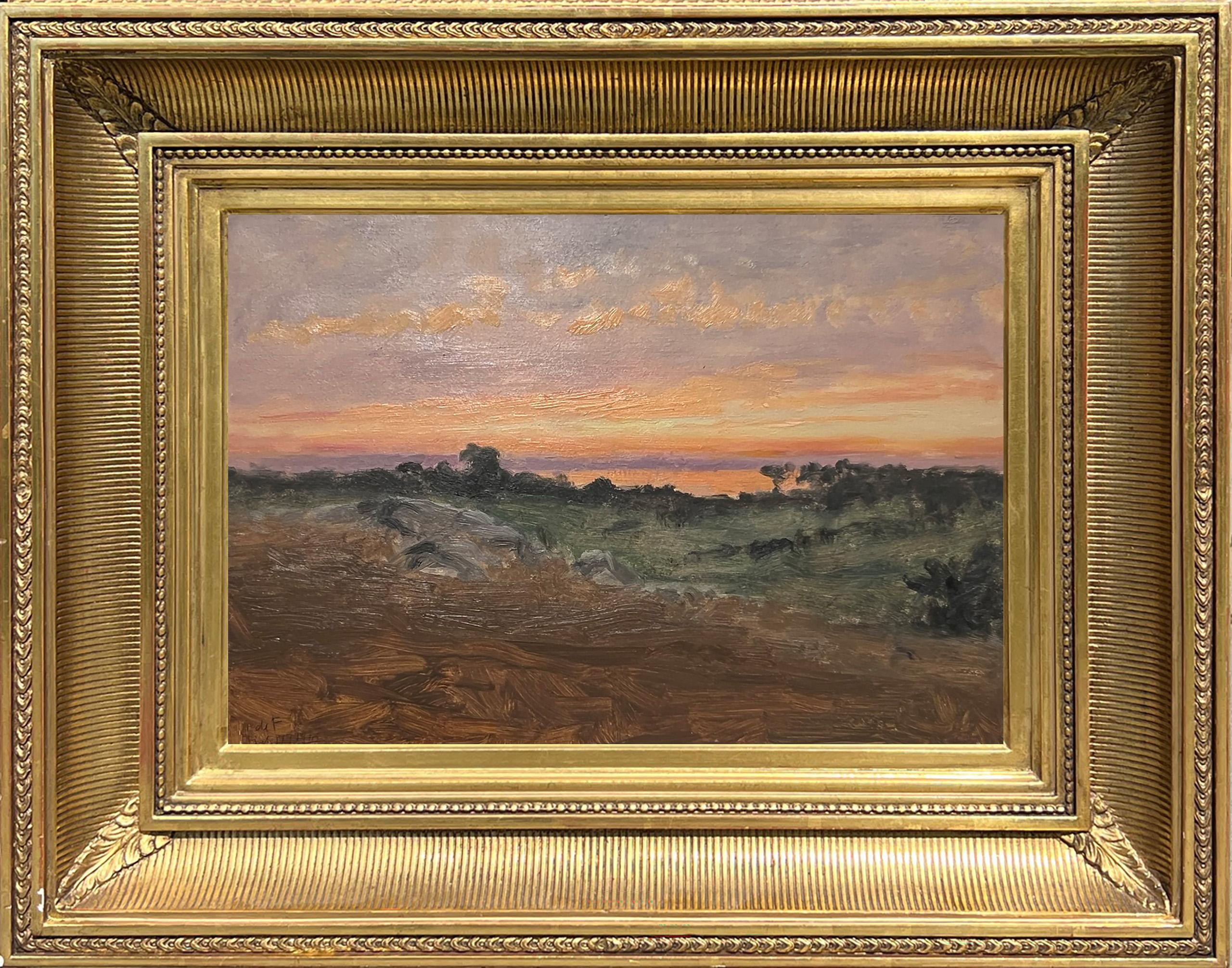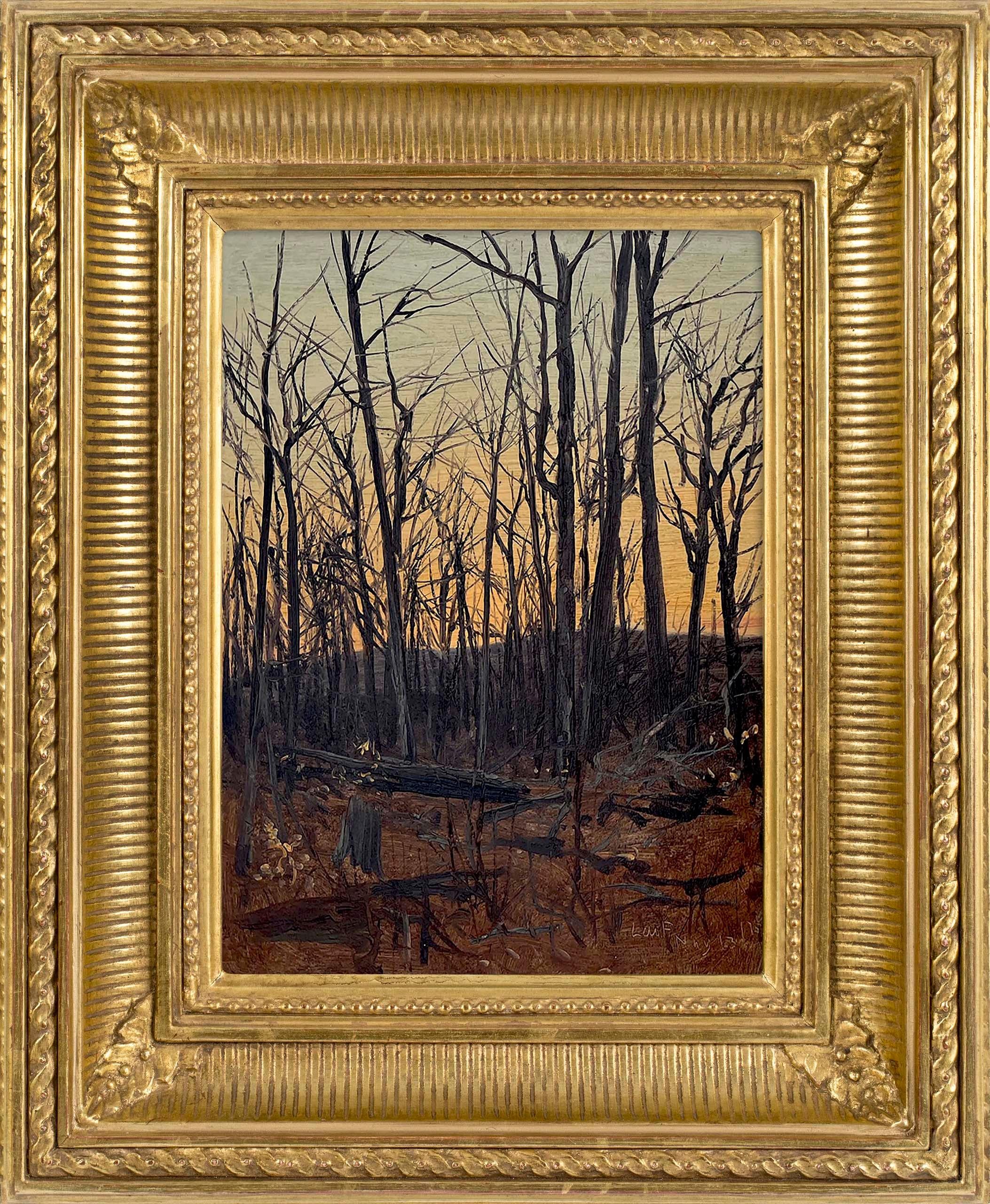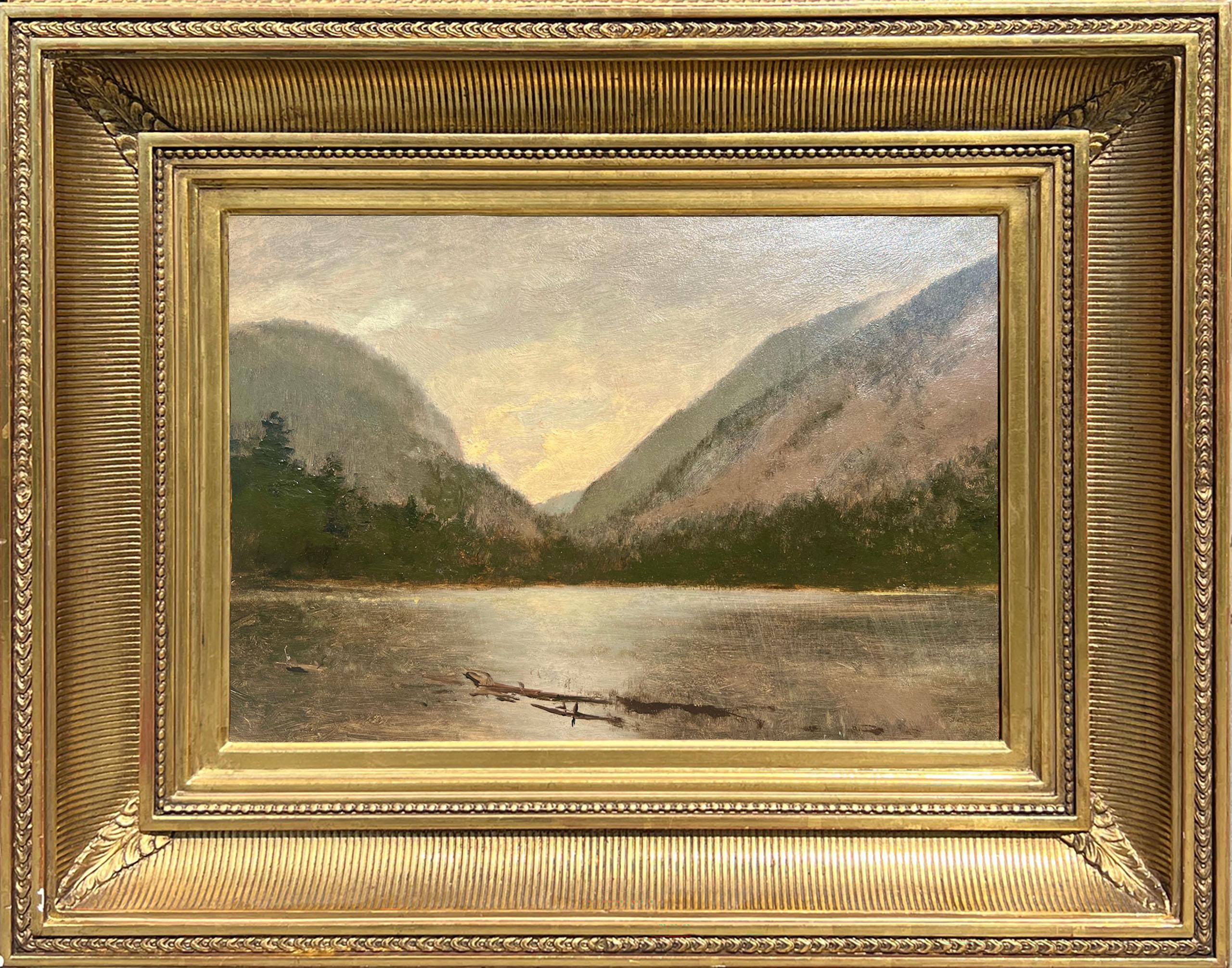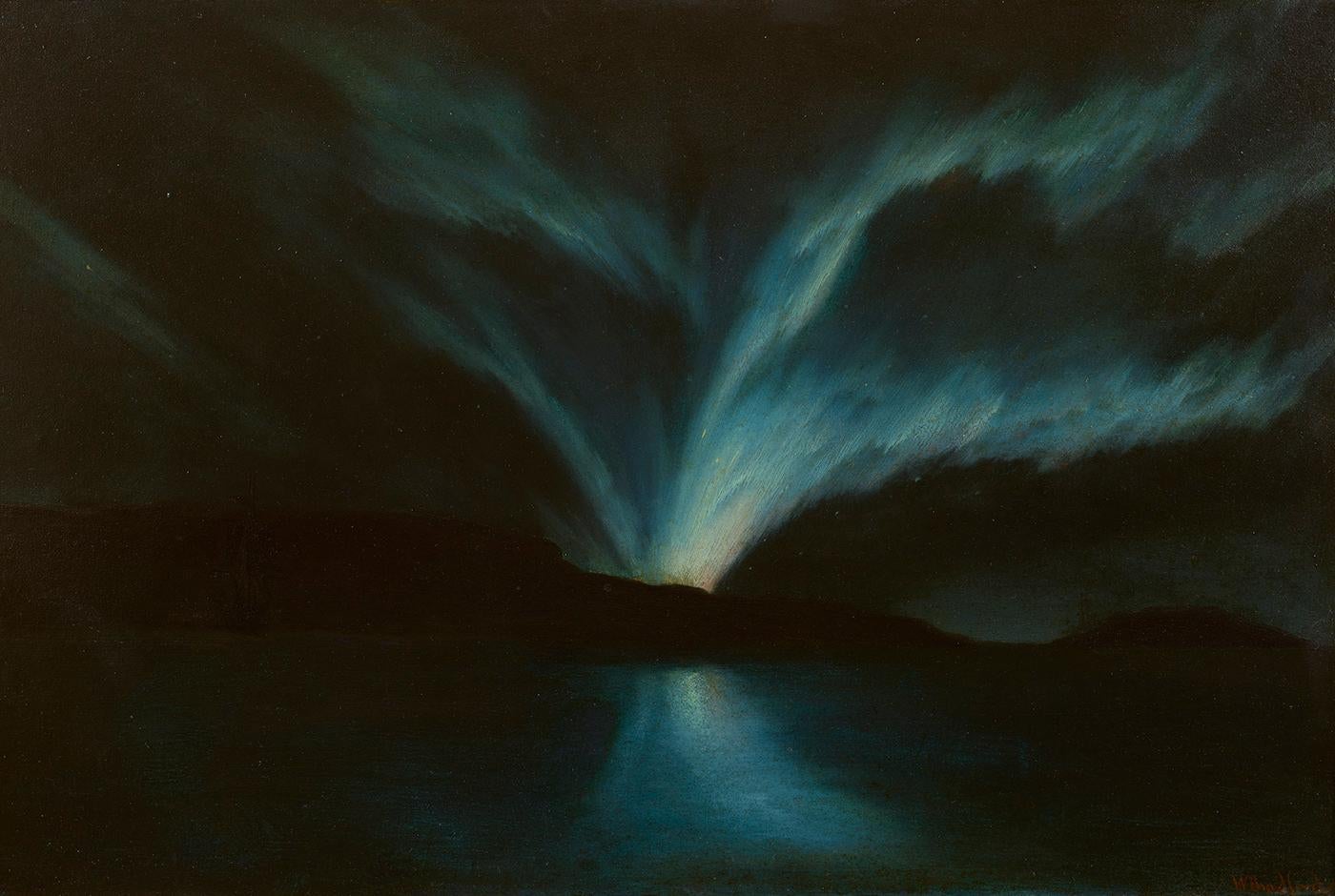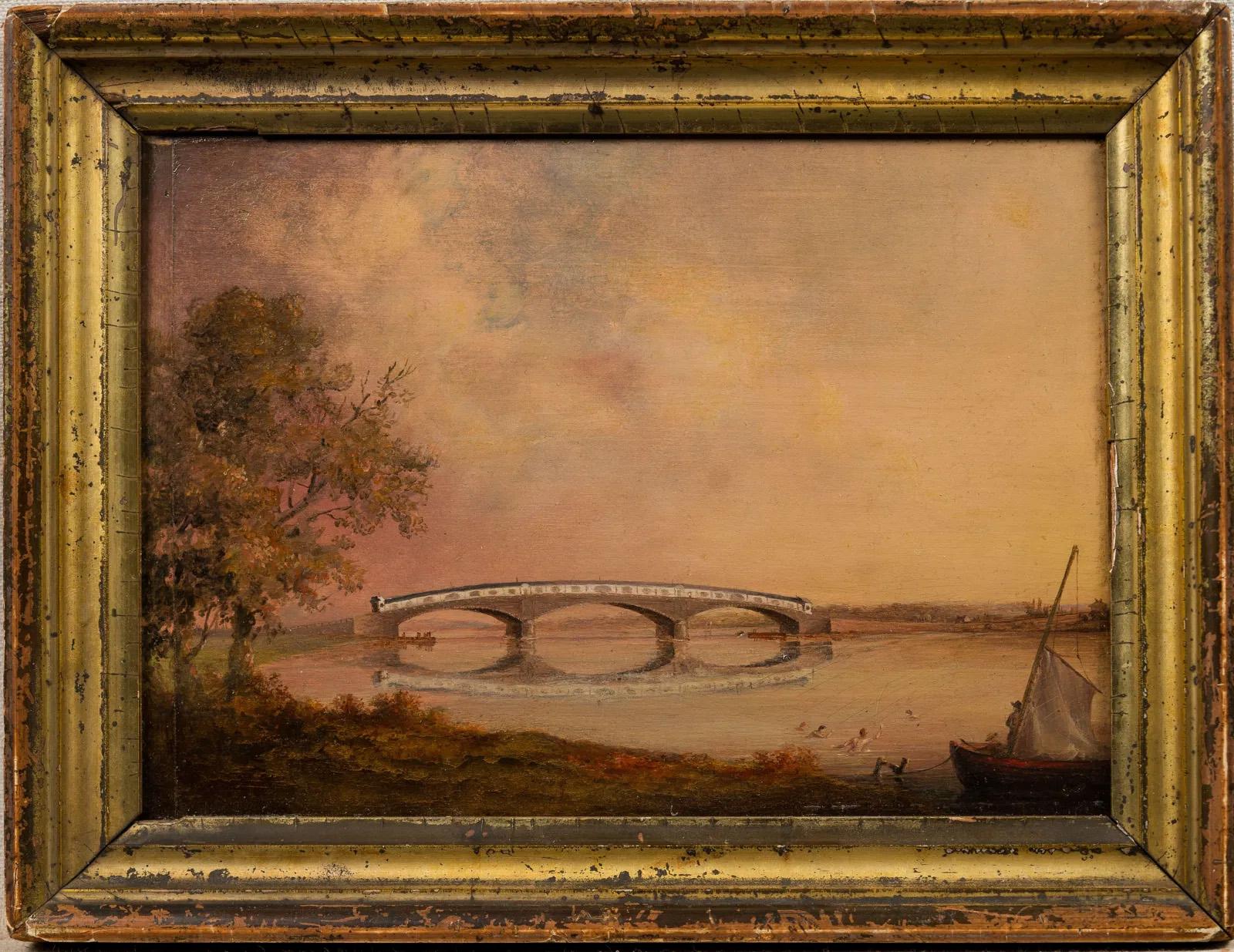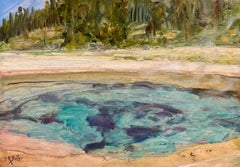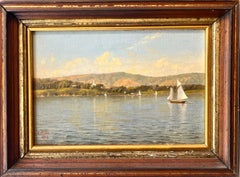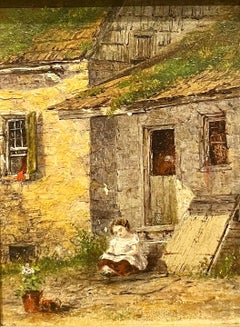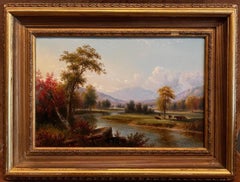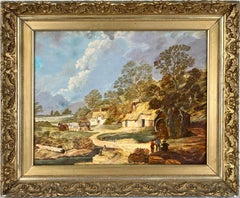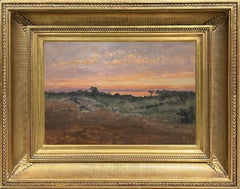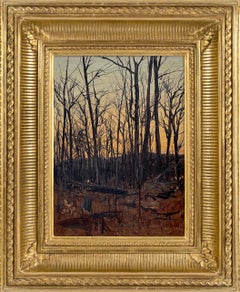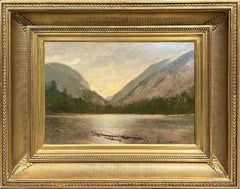Items Similar to A Thunder Shower on Lago Maggiore, North Italy
Want more images or videos?
Request additional images or videos from the seller
1 of 11
Thomas Ralph SpenceA Thunder Shower on Lago Maggiore, North Italyc. 1880s
c. 1880s
$4,500
£3,455.57
€3,964.08
CA$6,323.03
A$7,081.39
CHF 3,694.95
MX$86,496.16
NOK 47,010.57
SEK 44,313.10
DKK 29,583.45
About the Item
Thomas Ralph Spence’s "A Thunder Shower on Lago Maggiore, North Italy" captures a dramatic moment of nature’s power over the serene landscape of Lago Maggiore. Known for his architectural and artistic works, Spence brings a keen eye for detail and atmosphere to this piece, portraying the impending storm with dynamic brushwork and a vivid sense of place.
The scene depicts dark, rolling clouds gathering over the lake, casting shadows over the distant mountains and reflecting on the water's surface. The contrast between the tranquil waters and the ominous storm clouds evokes a sense of anticipation and awe. The landscape is both poetic and grand, with the artist’s handling of light and shadow adding to the intensity of the approaching storm. This painting is signed and detailed on back.
Spence's ability to convey emotion through landscape painting is evident here, as the viewer is drawn into the scene, feeling both the calm before the storm and the tension in the air. This work exemplifies Spence’s mastery of mood and his deep appreciation for the natural and architectural beauty of Italy.
- Creator:Thomas Ralph Spence (1845 - 1918, British)
- Creation Year:c. 1880s
- Dimensions:Height: 12.25 in (31.12 cm)Width: 18.5 in (46.99 cm)
- Medium:
- Movement & Style:
- Period:
- Condition:
- Gallery Location:Fredericksburg, VA
- Reference Number:1stDibs: LU2574214949162
About the Seller
5.0
Vetted Professional Seller
Every seller passes strict standards for authenticity and reliability
Established in 2001
1stDibs seller since 2023
19 sales on 1stDibs
- ShippingRetrieving quote...Shipping from: Fredericksburg, VA
- Return Policy
Authenticity Guarantee
In the unlikely event there’s an issue with an item’s authenticity, contact us within 1 year for a full refund. DetailsMoney-Back Guarantee
If your item is not as described, is damaged in transit, or does not arrive, contact us within 7 days for a full refund. Details24-Hour Cancellation
You have a 24-hour grace period in which to reconsider your purchase, with no questions asked.Vetted Professional Sellers
Our world-class sellers must adhere to strict standards for service and quality, maintaining the integrity of our listings.Price-Match Guarantee
If you find that a seller listed the same item for a lower price elsewhere, we’ll match it.Trusted Global Delivery
Our best-in-class carrier network provides specialized shipping options worldwide, including custom delivery.More From This Seller
View AllYellowstone Geyser
Located in Fredericksburg, VA
This painting by Howard Russell Butler captures the serene, almost mystical presence of a Yellowstone geyser in a moment of stillness. Known for his ability to portray the grandeur o...
Category
Early 20th Century Hudson River School Landscape Paintings
Materials
Oil, Board
Oil Miniature Sailboat Landscape
Located in Fredericksburg, VA
Frederick J. Sykes (1851-1905) was a remarkable artist of the Hudson River School, renowned for capturing the serene beauty of tranquil landscapes. His work often featured New Englan...
Category
Late 19th Century Hudson River School Landscape Paintings
Materials
Oil, Board
Little Girl Reading by House
By Edward Lamson Henry
Located in Fredericksburg, VA
"Reading After School," attributed to Edward Lamson Henry, offers a glimpse into the everyday moments of 19th-century American life. Known for his meticulous detail and his ability t...
Category
Late 19th Century Hudson River School Figurative Paintings
Materials
Oil, Board
Oil River Landscape
Located in Fredericksburg, VA
This 19th-century American School river landscape painting by an unknown artist embodies the essence of the era’s reverence for nature and the burgeoning national identity. These wor...
Category
Mid-19th Century Hudson River School Landscape Paintings
Materials
Oil, Board
Fishing Along the Meder River at the edge of Vic, Spain
Located in Fredericksburg, VA
Samuel Coleman's "Fishing Along the Meder River at the Edge of Vic, Spain" is a captivating painting that beautifully captures both the charm of the riverside, and the beauty of the ...
Category
Mid-19th Century Hudson River School Landscape Paintings
Materials
Oil, Board
Rocky Seashore
By Lemuel D. Eldred
Located in Fredericksburg, VA
"Rocky Seascape" by Lemuel D. Eldred is a captivating painting that masterfully captures the raw beauty and power of the sea. Eldred, an accomplished 19th-century American marine art...
Category
Mid-19th Century Hudson River School Landscape Paintings
Materials
Oil, Board
You May Also Like
Hudson River School Style - The Homestead and Grist Mill 1942
By A. Mathieu
Located in Soquel, CA
Hudson River School Style - The Homestead and Grist Mill 1942
In the Hudson River School style by A (K) Mathieu (American, 19th-20th C). Harvest time at the Homestead with a hay wago...
Category
1940s Hudson River School Figurative Paintings
Materials
Oil, Illustration Board, Stretcher Bars
New England Sunrise, 1910 by Lockwood DeForest (American, 1850-1932)
Located in New York, NY
"New England Sunrise," 1910 by Hudson River School painter Lockwood DeForest (American, 1850-1932) is oil on artists card-stock and measures 9.75 x 14 inches. The work is signed by DeForest and dated Sept. 17, 1910 at lower left. The work is framed in an elegant, period appropriate frame, and ready to hang.
Lockwood de Forest was born in New York in 1850 to a prominent family. He grew up in Greenwich Village and on Long Island at the family summer estate in Cold Spring Harbor. As was customary for a cultivated family in the Gilded Age, the de Forests made frequent trips abroad. Excursions to the great museums, which were prominent on the de Forests agenda, deepened the young Lockwood's familiarity with European painting and sculpture. Though he had begun drawing and painting somewhat earlier, it was during a visit to Rome in 1868 that nineteen-year-old de Forest first began to study art seriously, taking painting lessons from the Italian landscapist Hermann David Salomon Corrodi (1844–1905). More importantly, on the same trip, Lockwood met one of America’s most celebrated painters, (and his maternal great-
uncle by marriage) Frederic Edwin Church (1826–1900), who quickly became his mentor. DeForest accompanied Church on sketching trips around Italy and continued this practice when they both returned to America in 1869. Early on in his career, de Forest made a habit of recording the date and often the place of his oil sketches, as to create a visual diary of his travels. Lockwood’s profession as a landscape painter can be primarily attributed to Frederic E. Church and his belief in the young artist’s talent.
De Forest often visited Church in the Hudson River community of Catskill where, in addition to sketching trips and afternoons of painting, he assisted with the architectural drawings and planning of Olana. In 1872, de Forest took a studio at the Tenth Street Studio Building in New York. During these formative years de Forest counted among his friend’s artists such as Sanford Robinson Gifford (1823–80), George Henry Yewell (1830–1923), John Frederick Kensett (1816–72), Jervis McEntee (1828–91), and Walter Launt Palmer (1854–1932).
Over the next decade de Forest experienced success as a painter. He exhibited for the first time at the National Academy of Design in 1872, and made two more painting trips abroad, in 1875–76 and 1877–78, traveling to the major continental capitals but also the Middle East and North Africa. His trip to the Middle East and the library at Church’s home, Olana, established his interest in design during his mid-twenties. From about 1878 to 1902, landscape painting was overshadowed by his activities and preoccupation with East Indian architecture and décor, a style that became quite fashionable in late nineteenth century America. From 1879-1883, de Forest founded Associated Artists along with Louis Comfort Tiffany, Candace Wheeler...
Category
Early 20th Century Hudson River School Landscape Paintings
Materials
Oil, Board
Dusk Forest Scene, Catskills by Lockwood DeForest (American, 1850-1932)
Located in New York, NY
"Dusk Forest Scene, Catskills," 1875 by Hudson River School painter Lockwood DeForest (American, 1850-1932) is oil on artists card-stock and measures 9.5 x 7 inches. The work is signed by DeForest, and dated May 13, 1875 at lower right. The work is framed in an elegant, period appropriate frame, and ready to hang.
Lockwood de Forest was born in New York in 1850 to a prominent family. He grew up in Greenwich Village and on Long Island at the family summer estate in Cold Spring Harbor. As was customary for a cultivated family in the Gilded Age, the de Forests made frequent trips abroad. Excursions to the great museums, which were prominent on the de Forests agenda, deepened the young Lockwood's familiarity with European painting and sculpture. Though he had begun drawing and painting somewhat earlier, it was during a visit to Rome in 1868 that nineteen-year-old de Forest first began to study art seriously, taking painting lessons from the Italian landscapist Hermann David Salomon Corrodi (1844–1905). More importantly, on the same trip, Lockwood met one of America’s most celebrated painters, (and his maternal great-
uncle by marriage) Frederic Edwin Church (1826–1900), who quickly became his mentor. DeForest accompanied Church on sketching trips around Italy and continued this practice when they both returned to America in 1869. Early on in his career, de Forest made a habit of recording the date and often the place of his oil sketches, as to create a visual diary of his travels. Lockwood’s profession as a landscape painter can be primarily attributed to Frederic E. Church and his belief in the young artist’s talent.
De Forest often visited Church in the Hudson River community of Catskill where, in addition to sketching trips and afternoons of painting, he assisted with the architectural drawings and planning of Olana. In 1872, de Forest took a studio at the Tenth Street Studio Building in New York. During these formative years de Forest counted among his friend’s artists such as Sanford Robinson Gifford (1823–80), George Henry Yewell (1830–1923), John Frederick Kensett (1816–72), Jervis McEntee (1828–91), and Walter Launt Palmer (1854–1932).
Over the next decade de Forest experienced success as a painter. He exhibited for the first time at the National Academy of Design in 1872, and made two more painting trips abroad, in 1875–76 and 1877–78, traveling to the major continental capitals but also the Middle East and North Africa. His trip to the Middle East and the library at Church’s home, Olana, established his interest in design during his mid-twenties. From about 1878 to 1902, landscape painting was overshadowed by his activities and preoccupation with East Indian architecture and décor, a style that became quite fashionable in late nineteenth century America. From 1879-1883, de Forest founded Associated Artists along with Louis Comfort Tiffany, Candace Wheeler...
Category
19th Century Hudson River School Landscape Paintings
Materials
Oil, Board
Hudson Highlands by Lockwood DeForest (American, 1850-1932)
Located in New York, NY
"Hudson Highlands," by Hudson River School painter Lockwood DeForest (American, 1850-1932) is oil on artists card-stock and measures 9.5 x 14 inches. The work is framed in an elegant, period appropriate frame, and ready to hang.
Lockwood de Forest was born in New York in 1850 to a prominent family. He grew up in Greenwich Village and on Long Island at the family summer estate in Cold Spring Harbor. As was customary for a cultivated family in the Gilded Age, the de Forests made frequent trips abroad. Excursions to the great museums, which were prominent on the de Forests agenda, deepened the young Lockwood's familiarity with European painting and sculpture. Though he had begun drawing and painting somewhat earlier, it was during a visit to Rome in 1868 that nineteen-year-old de Forest first began to study art seriously, taking painting lessons from the Italian landscapist Hermann David Salomon Corrodi (1844–1905). More importantly, on the same trip, Lockwood met one of America’s most celebrated painters, (and his maternal great-
uncle by marriage) Frederic Edwin Church (1826–1900), who quickly became his mentor. DeForest accompanied Church on sketching trips around Italy and continued this practice when they both returned to America in 1869. Early on in his career, de Forest made a habit of recording the date and often the place of his oil sketches, as to create a visual diary of his travels. Lockwood’s profession as a landscape painter can be primarily attributed to Frederic E. Church and his belief in the young artist’s talent.
De Forest often visited Church in the Hudson River community of Catskill where, in addition to sketching trips and afternoons of painting, he assisted with the architectural drawings and planning of Olana. In 1872, de Forest took a studio at the Tenth Street Studio Building in New York. During these formative years de Forest counted among his friend’s artists such as Sanford Robinson Gifford (1823–80), George Henry Yewell (1830–1923), John Frederick Kensett (1816–72), Jervis McEntee (1828–91), and Walter Launt Palmer (1854–1932).
Over the next decade de Forest experienced success as a painter. He exhibited for the first time at the National Academy of Design in 1872, and made two more painting trips abroad, in 1875–76 and 1877–78, traveling to the major continental capitals but also the Middle East and North Africa. His trip to the Middle East and the library at Church’s home, Olana, established his interest in design during his mid-twenties. From about 1878 to 1902, landscape painting was overshadowed by his activities and preoccupation with East Indian architecture and décor, a style that became quite fashionable in late nineteenth century America. From 1879-1883, de Forest founded Associated Artists along with Louis Comfort Tiffany, Candace Wheeler...
Category
19th Century Hudson River School Landscape Paintings
Materials
Oil, Board
Lights of the Aurora
By William Bradford
Located in New York, NY
Signed lower right: W Bradford
Category
Late 19th Century Hudson River School Landscape Paintings
Materials
Oil, Board
Antique Early American Southern Hudson River School Boys Swimming Oil Painting
Located in Buffalo, NY
Rare early American sunset Hudson River School swimming hole painting. Framed. Oil on board. Image size, 7.25H by 10L.
Category
1860s Hudson River School Portrait Paintings
Materials
Oil, Board
$3,000 Sale Price
20% Off
More Ways To Browse
Shower Painting
Antique Showers
Ralph Hudson
Lago Maggiore
Lake Maggiore
English Countryside Oil On Canvas
Hawaii Beach Paintings
Oil Paintings Iowa
Painting Signed Franklin
Antique Silhouette Paintings
Native American Horse
Oil Painting Carriage
San Francisco Seascape
Big Ben
Mid Century Beach Scene Painting
Hays Oil Painting
Newport Oil Painting
Skyscapes Art
